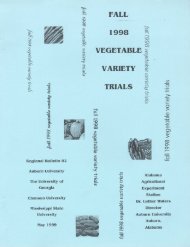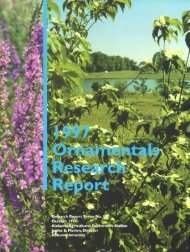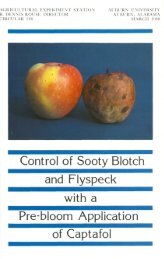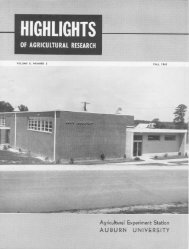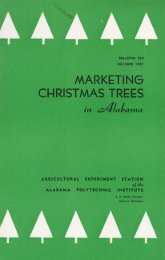Phytoplankton and Water Quality in a Fertilized Fish Pond 4
Phytoplankton and Water Quality in a Fertilized Fish Pond 4
Phytoplankton and Water Quality in a Fertilized Fish Pond 4
You also want an ePaper? Increase the reach of your titles
YUMPU automatically turns print PDFs into web optimized ePapers that Google loves.
AGRICULTURAL EXPERIMENT STATION / AUBURN UNIVERSITY<br />
R. Dennis Rouse, Director Auburn, Alabama<br />
<strong>Phytoplankton</strong> <strong>and</strong><br />
<strong>Water</strong> <strong>Quality</strong> <strong>in</strong> a<br />
<strong>Fertilized</strong> <strong>Fish</strong> <strong>Pond</strong> 4<br />
CIRCULAR 224<br />
NOVEMBER 1975
CONTENTS<br />
METHODS AND MATERIALS --------------- -3<br />
Page<br />
T he Study Area---- --- ---- --- ---- --- ---- - -- - - 3<br />
<strong>Phytoplankton</strong> <strong>and</strong> Chemical Analysis-4<br />
Physical Conditions --- -- --- -- --- ----- -- -- -- 4<br />
RESULTS AND DIScUSSION-------------- ----- -5<br />
<strong>Phytoplankton</strong> - - - - - - - - - - - - - - - - 5---<br />
W ater Temperature------------------ --- -10<br />
D issolved O xygen ---- ---- ---- --- ---- ---- - --- -13<br />
Light- - - - - -13-- - - - - ---------------------<br />
A lkal<strong>in</strong>ity <strong>and</strong> pH ---- ---- ---- --- ---- ---- ---- -14<br />
Nitrogen <strong>and</strong> Phosphorus ---------- -14<br />
LITERATURE CITED ------------------------------------ 16<br />
FIRST PRINTING 2M, NOVEMBER 1975<br />
SECOND PRINTING 2M, OCTOBER 1976<br />
Auhurn University is an equal opportunity employer<br />
[2]
<strong>Phytoplankton</strong> <strong>and</strong> <strong>Water</strong> <strong>Quality</strong><br />
<strong>in</strong> A <strong>Fertilized</strong> <strong>Fish</strong> <strong>Pond</strong>'<br />
R. W. PARKS, ELLEN SCARSBROOK, <strong>and</strong> C. E. BOYD 2<br />
FERTILIZERS<br />
ARE FREQUENTLY added to fish ponds to <strong>in</strong>crease<br />
the abundance of microscopic plants (phytoplankton) <strong>and</strong> animals<br />
(zooplankton) <strong>and</strong> thereby stimulate fish production (17,<br />
22). High concentrations of nutrients often favor the development<br />
of dense blooms of blue-green algae (5). Under certa<strong>in</strong><br />
conditions, heavy blooms of blue-green algae are responsible for<br />
a number of problems <strong>in</strong> ponds, <strong>in</strong>clud<strong>in</strong>g odors (21), bad tastes<br />
<strong>in</strong> fish (15), presence of toxic substances (21), <strong>and</strong> shallow chemical<br />
<strong>and</strong> thermal stratification of the water (4). Some populations<br />
of algae, particularly species of Microcystis <strong>and</strong> Anabaena, may<br />
die suddenly (8,23). Decomposition may cause oxygen depletion<br />
<strong>and</strong> fish kills (8,23).<br />
The present <strong>in</strong>vestigation was <strong>in</strong>itiated to monitor changes <strong>in</strong><br />
phytoplankton <strong>and</strong> water quality <strong>in</strong> a fertilized fish pond. Emphasis<br />
was given to determ<strong>in</strong><strong>in</strong>g relationships between the abundance<br />
<strong>and</strong> periodicity of phytoplankton <strong>and</strong> changes <strong>in</strong> water<br />
quality.<br />
METHODS AND MATERIALS<br />
The Study Area<br />
<strong>Pond</strong> S-3 on the <strong>Fish</strong>eries Research Unit of the Auburn University<br />
Agricultural Experiment Station has an area of 9.75 acres<br />
<strong>and</strong> an average depth of about 5 feet. It is filled by overflow<br />
from other ponds (S-2, S-24, <strong>and</strong> S-25) <strong>and</strong> by runoff. The pond<br />
1 This research was supported by the Office of <strong>Water</strong> Research <strong>and</strong> Technology<br />
the Department of the Interior through the <strong>Water</strong> Resources Research Institute<br />
of Auburn University under provisions of the <strong>Water</strong> Research Act of 1964.<br />
2 Graduate Assistant, Research Associate, <strong>and</strong> Associate Professor, respectively,<br />
Department of <strong>Fish</strong>eries <strong>and</strong> Allied Aquacultures.<br />
[38
was dra<strong>in</strong>ed <strong>in</strong> November, 1967, <strong>and</strong> stocked on February 5,<br />
1968, with 9,780 f<strong>in</strong>gerl<strong>in</strong>g bluegill sunfish (Lepomis macrochirus<br />
Raf<strong>in</strong>esque), 4,875 f<strong>in</strong>gerl<strong>in</strong>g redear sunfish (Lepomis microlophus<br />
(Gunther)), 19,500 fathead m<strong>in</strong>nows (Pimephales promelas Raf<strong>in</strong>esque),<br />
<strong>and</strong> 20 subadult largemouth bass (Micropterus salmoides<br />
(Lacepede)). Threadf<strong>in</strong> shad, Signalosa petenensis<br />
(Gunther) were also present. Ten applications of 17.4 pounds<br />
per acre of triple superphosphate were made dur<strong>in</strong>g each grow<strong>in</strong>g<br />
season. <strong>Fish</strong><strong>in</strong>g was allowed <strong>in</strong> the pond on a limited basis.<br />
<strong>Phytoplankton</strong> <strong>and</strong> Chemical Analyses<br />
A sampl<strong>in</strong>g station was selected near the dam of S-3 where<br />
the depth of water was 10 feet. <strong>Water</strong> for phytoplankton enumeration<br />
was collected at 18-<strong>in</strong>ch <strong>in</strong>tervals with a weighted bottle<br />
sampler (16). Samples were taken at approximately 8 a.m. at 2<br />
or 3-day <strong>in</strong>tervals while phytoplankton growth was slow, <strong>and</strong><br />
daily when phytoplankton was grow<strong>in</strong>g rapidly. <strong>Phytoplankton</strong><br />
was concentrated by filtration through s<strong>and</strong> <strong>and</strong> counted <strong>in</strong> a<br />
count<strong>in</strong>g chamber under a microscope fitted with an ocular micrometer<br />
(2).<br />
Dissolved oxygen determ<strong>in</strong>ations were made at the various<br />
depths at the sampl<strong>in</strong>g station with a polarographic oxygen meter.<br />
<strong>Water</strong> samples for chemical analyses were taken each time<br />
phytoplankton samples were collected. These samples were collected<br />
with a brass water column sampler which enclosed a<br />
column of water 36 <strong>in</strong>ches <strong>in</strong> length by 2 <strong>in</strong>ches <strong>in</strong> diameter (5).<br />
Soluble orthophosphate, nitrate, <strong>and</strong> ammonia concentrations<br />
were measured by st<strong>and</strong>ard colorimetric procedures described by<br />
the American Public Health Association (2). Alkal<strong>in</strong>ity was measured<br />
by titration with 0.02N H 2SO4 <strong>and</strong> free carbon dioxide was<br />
titrated with 0.02N NaOH (2). A glass electrode was used to<br />
measure pH.<br />
Physical Conditions<br />
A temperature profile was taken on each sampl<strong>in</strong>g date with<br />
a submersible thermometer. An underwater light meter was used<br />
to measure light <strong>in</strong>tensities at 18-<strong>in</strong>ch <strong>in</strong>tervals. A Secchi disk<br />
was used to determ<strong>in</strong>e the depth of visibility on each sampl<strong>in</strong>g<br />
date. A record<strong>in</strong>g solarimeter recorded <strong>in</strong>com<strong>in</strong>g solar radiation<br />
cont<strong>in</strong>uously from a location on the shore of the pond. Records<br />
of average daily air temperature <strong>and</strong> total daily w<strong>in</strong>d run were<br />
[4]
obta<strong>in</strong>ed from the Environmental Studies Service Center, Auburn<br />
University. The data were collected at a weather station on the<br />
Auburn University campus.<br />
RESULTS AND DISCUSSION<br />
<strong>Phytoplankton</strong><br />
Data on the abundance of different genera of phytoplankton<br />
are presented <strong>in</strong> figures 1, 2, 3, 4, <strong>and</strong> 5. Two genera, Anabaena<br />
<strong>and</strong> Microcystis, were more important numerically <strong>and</strong> ecologically<br />
than other genera. The abundance of these two genera is<br />
reported as <strong>in</strong>dividuals per milliliter, figures 1 <strong>and</strong> 2. The abundance<br />
of other genera is expressed as logarithms to the base 10<br />
of the numbers of <strong>in</strong>dividuals per milliliter, figures 3, 4, <strong>and</strong> 5.<br />
Algae present <strong>in</strong> the w<strong>in</strong>ter <strong>and</strong> early spr<strong>in</strong>g <strong>in</strong>cluded the follow<strong>in</strong>g<br />
groups; blue-green algae-Anabaena, Microcystis, Spirul<strong>in</strong>a,<br />
Oscillatoria, Raphidiopsis, <strong>and</strong> Gomphosphaeria, green algae-<br />
Selenastrum, Kirchneriella, Consmarium, Arthrodesmus, Staurastrum,<br />
Sphaerocystis, P<strong>and</strong>or<strong>in</strong>a, <strong>and</strong> Oocystis, euglenophytes -<br />
Trachelomonas. In late March, Anabaena began to <strong>in</strong>crease <strong>in</strong><br />
abundance <strong>and</strong> dur<strong>in</strong>g late April <strong>and</strong> May <strong>in</strong>dividuals of this<br />
genus comprised 50 percent or more of the total phytoplankton.<br />
Most of the other genera decl<strong>in</strong>ed <strong>in</strong> abundance or disappeared<br />
from the phytoplankton community with the <strong>in</strong>crease <strong>in</strong> Anabaena.<br />
Filaments of Anabaena were buoyant <strong>and</strong> accumulated <strong>in</strong> the<br />
surface water, Figure 1. Buoyancy of the blue-green algae results<br />
from gas vacuoles which form <strong>in</strong> cells exposed to low light<br />
<strong>in</strong>tensity (10,11). Plankton absorbs <strong>and</strong> reflects light <strong>and</strong> is a<br />
major factor affect<strong>in</strong>g the penetration of light <strong>in</strong> fertilized ponds<br />
(4). Therefore, the depth of penetration of adequate light for<br />
photosynthesis is <strong>in</strong>versely related to the abundance of phytoplankton<br />
(4). Surface scums of Anabaena formed on calm days<br />
<strong>and</strong> drifted to the leeward shore. Moderate or heavy w<strong>in</strong>ds or<br />
ra<strong>in</strong> prevented scums by mix<strong>in</strong>g Anabaena <strong>in</strong> the water column.<br />
A number of partial die-offs of Anabaena occurred between late<br />
March <strong>and</strong> early June. The dates for five of the best def<strong>in</strong>ed dieoffs<br />
are marked on Figure 1. Data on weather conditions, which<br />
were apparently responsible for die-offs, are presented <strong>in</strong> figures<br />
6 <strong>and</strong> 7. A similar pattern of events was associated with each<br />
die-off. Surface scums of Anabaena were present <strong>in</strong> the morn<strong>in</strong>g<br />
after a night of calm weather. On clear calm days, the scum per-<br />
[5]
sisted <strong>and</strong> the bright light apparently <strong>in</strong>jured filaments <strong>in</strong> the<br />
scum. Algae <strong>in</strong> the scum turned brown by afternoon <strong>and</strong> began<br />
to dis<strong>in</strong>tegrate <strong>and</strong> decompose. These observations are <strong>in</strong> agreement<br />
with f<strong>in</strong>d<strong>in</strong>gs for another pond where light <strong>in</strong>jury to Anabaena<br />
<strong>in</strong> a surface scum apparently triggered a massive phytoplankton<br />
die-off with subsequent depletion of dissolved oxygen<br />
(8). Fortunately, only a portion of the Anabaena <strong>in</strong> S-3 died on<br />
40<br />
35-<br />
Surface<br />
30 - Anoboeno circ<strong>in</strong>olis<br />
25- i-1 Other Phytoplonkton<br />
20<br />
15<br />
10<br />
5<br />
0<br />
O-<br />
10<br />
15 5 Average af all depths<br />
0<br />
February March April May June<br />
FIG. 1. Abundance of Anabaena <strong>in</strong> relation to the total abundance of phytoplankton<br />
<strong>in</strong> S-S. Arrows <strong>in</strong>dicate partial die-offs of Anabaena.<br />
[6]
each occasion, Figure 1, <strong>and</strong> water quality was not seriously<br />
impaired.<br />
Observations made dur<strong>in</strong>g the present study do not reveal the<br />
mechanism by which Anabaena atta<strong>in</strong>ed dom<strong>in</strong>ance <strong>in</strong> the phytoplankton<br />
community. However, the two follow<strong>in</strong>g possibilities<br />
are most appeal<strong>in</strong>g to the authors. First, the buoyant filaments<br />
of Anabaena accumulated near the surface <strong>and</strong> shaded phytoplankton<br />
that was unable to rise towards the surface where<br />
light <strong>in</strong>tensities were higher. Second, laboratory studies have<br />
revealed that Anabaena excretes substances <strong>in</strong>to the water which<br />
are toxic to other algae (6,19). Admittedly, many other factors<br />
0<br />
30 Surface d Microcysfis aerug<strong>in</strong>osa<br />
20 0 Other <strong>Phytoplankton</strong><br />
I0L<br />
0<br />
20-<br />
I0<br />
20<br />
3 feet<br />
20t 6 'feet<br />
10<br />
U)10-<br />
0-<br />
20- Average<br />
10-<br />
0-<br />
May June July August<br />
FIG. 2. Abundance of Microcystis <strong>in</strong> relation to the total abundance of phytoplankton<br />
<strong>in</strong> S-3.<br />
[7]
<strong>in</strong>clud<strong>in</strong>g temperature, pH, <strong>and</strong> nutrient concentrations may also<br />
have contributed to the <strong>in</strong>crease <strong>in</strong> Anabaera.<br />
The abundance of Microcystis <strong>in</strong>creased rapidly <strong>in</strong> June after<br />
Anabaena decl<strong>in</strong>ed <strong>in</strong> number. The abundance of Microcystis<br />
also was greater <strong>in</strong> surface waters, Figure 2, <strong>and</strong> surface scums<br />
of Microcystis were observed often. No die-offs or scums of<br />
Microcystis occurred. This suggests that bright light was not<br />
as harmful to Microcystis as it was to Anabaena. A number of<br />
genera, Microcystis, Selenastrum, Arthrodesmus, Spirul<strong>in</strong>a, Meiismopedia,<br />
Oscillatoria, Raphidiopsis, Gomphosphaeria, Sphaerocystis,<br />
Trachelomonas, J<strong>and</strong>or<strong>in</strong>a, Qocystis, Kirchneriella, Cosmariun,<br />
<strong>and</strong> Staurastrum were present <strong>in</strong> samples taken on one<br />
JI<br />
On 2<br />
2 Se/enstrum<br />
2L~<br />
2 Kirchnerie//a<br />
42 ~Cisritim<br />
Atrodesmus<br />
-F M A M J J A<br />
FIG. 3. Seasonal succession of plamktonic algae <strong>in</strong> S-3 from February 1974 to<br />
September 1974. Data represent the average abundance of phytoplankton <strong>in</strong> the<br />
water column.<br />
[8 ]
2 Sp/aerocysfis<br />
2 Troche/omonas<br />
E<br />
o 2 a 2 P<strong>and</strong>er/no<br />
o<br />
2 Oocystis<br />
F M A M J J A S<br />
FIG. 4. Seasonal succession of planktonic algae <strong>in</strong> S-3 from February 1974 to<br />
September 1974. Data represent the average abundance of phytoplankton <strong>in</strong> the<br />
water column.<br />
or more dates between June 1 <strong>and</strong> August 15. Individuals of<br />
Microcystis greatly outnumbered <strong>in</strong>dividuals of any other genus<br />
dur<strong>in</strong>g this time. Reasons for the dom<strong>in</strong>ance of Microcystis cannot<br />
be expla<strong>in</strong>ed from data at h<strong>and</strong>. Microcystis is known to<br />
excrete substances toxic to other algae (6,19) <strong>and</strong> <strong>in</strong>dividuals of<br />
this genus have a competitive advantage for light <strong>and</strong> carbon<br />
dioxide s<strong>in</strong>ce they accumulate near the surface.<br />
The abundance of Microcystis decl<strong>in</strong>ed to a low level after<br />
August 15. Three .other blue-green algae, Spirul<strong>in</strong>a, Merismopedia,<br />
<strong>and</strong> Oscillatoria were abundant after the decl<strong>in</strong>e of Microcystis.<br />
The decl<strong>in</strong>e of Microcystis may have been related to any one or<br />
more of the factors mentioned above.<br />
Changes <strong>in</strong> the abundance of <strong>in</strong>dividual species of phytoplankton<br />
such as those observed <strong>in</strong> S-3 are common <strong>in</strong> natural waters<br />
(7,9,20,22,25). These changes have been attributed to a number<br />
of factors <strong>in</strong>clud<strong>in</strong>g, pH, temperature, nutrient concentrations,<br />
[9]
2 r Spiruhrno rrn<br />
2<br />
0 2<br />
° 'FF<br />
2 Merismopedia<br />
Oscil/aloria<br />
2 Rophidiopsis<br />
2,-.<br />
2<br />
Gomphosphaerio<br />
F M A M J J A S<br />
FIG. 5. Seasonal succession of planktonic algae <strong>in</strong> S-3 from February 1974 to<br />
September 1974. Data represent the average abundance of phytoplankton <strong>in</strong> the<br />
water column.<br />
light, weather, diseases, parasites, graz<strong>in</strong>g by fish <strong>and</strong> zooplankton,<br />
<strong>and</strong> tox<strong>in</strong>s (9). Unfortunately, data collected <strong>in</strong> most studies<br />
have not been adequate to isolate with certa<strong>in</strong>ty the factor or<br />
factors affect<strong>in</strong>g these changes <strong>in</strong> algal species.<br />
<strong>Water</strong> Temperature<br />
<strong>Water</strong> <strong>in</strong> S-3 was nearly isothermal <strong>in</strong> the early morn<strong>in</strong>g from<br />
February until early March, Figure 8. <strong>Water</strong> temperatures, then<br />
<strong>in</strong>creased faster <strong>in</strong> the upper 3 feet of. water than <strong>in</strong> the lower<br />
waters, <strong>and</strong> on March 10 the surface water was 22 ° Fahrenheit<br />
warmer than water at a depth of 9 feet. Heavy w<strong>in</strong>ds dur<strong>in</strong>g<br />
[10]
8<br />
7<br />
E 6<br />
5-<br />
a) 4<br />
3<br />
CD a) 2<br />
a I<br />
0<br />
80<br />
CZ<br />
°--70<br />
S60<br />
'a 50<br />
H40-<br />
< 30<br />
February March April May June July August<br />
FIG. 6. Mean air temperatures <strong>and</strong> total w<strong>in</strong>d runs as recorded by the Environmental<br />
Studies Service Center, Auburn University, Auburn, Alabama. Arrows<br />
<strong>in</strong>dicate times when partial die-offs of Anabaena occurred.<br />
FIG. 7. Incident solar radiation <strong>and</strong> underwater light penetration for pond S-3.<br />
[ 11 ]
mid March mixed the waters, <strong>and</strong> by March 25 waters were<br />
aga<strong>in</strong> almost isothermal. There was a general subsidence of w<strong>in</strong>ds<br />
as spr<strong>in</strong>g progressed <strong>and</strong> water temperatures stratified aga<strong>in</strong>.<br />
Surface waters were usually 15 ° to 20 ° Fahrenheit warmer than<br />
bottom waters from mid April until the end of the study <strong>in</strong> early<br />
September. Temperatures at the Surface <strong>and</strong> at a depth of 3<br />
feet were usually similar, but below 3 feet temperatures dropped<br />
sharply. There was little mix<strong>in</strong>g of the upper 3 feet of water with<br />
deeper water.<br />
The average temperature of the water column <strong>in</strong>creased as the<br />
study progressed; 50 ° Fahrenheit on February 26, 74 ° Fahrenheit<br />
on May 25, <strong>and</strong> 81 ° Fahrenheit on August 27. The plankton<br />
organisms absorbed heat <strong>and</strong> <strong>in</strong>creased the heat content of near<br />
surface waters. W<strong>in</strong>d mix<strong>in</strong>g of the surface water aided <strong>in</strong> distribut<strong>in</strong>g<br />
heat with<strong>in</strong> the upper 3 or 4 feet.<br />
Warm<strong>in</strong>g of the water column has a direct effect on phytoplankton<br />
succession. Hammer (12) found that blooms of blue-green<br />
algae appeared <strong>in</strong> Canadian lakes when water temperatures <strong>in</strong>creased<br />
above 570 Fahrenheit. In S-3, the appearance of dense<br />
blooms of Anabaena occurred when surface waters reached 59 °<br />
U-<br />
80-<br />
70<br />
E 601<br />
0<br />
50<br />
12<br />
Q 10<br />
a.<br />
S6<br />
0 4<br />
o<br />
8<br />
._ 0<br />
SSurface<br />
---- 3 feet<br />
feet<br />
9 feet<br />
. . . . . II . . . . .<br />
.6<br />
-I I I I II I<br />
- . i \ ' 1 .: ! ... v i " V \;.. . I- \ 1 \\ / 1 1\ /\<br />
11/1'<br />
-1 1 1I I i 1 I i i1 I i I 1 1 1I JI I I I I I tI 1 1! I i i 1 i I 1 I<br />
February March April May June July August<br />
FIG. 8. Dissolved oxygen <strong>and</strong> temperature data for selected depths <strong>in</strong> S-3.<br />
[12]
2:8<br />
a<br />
IO<br />
6<br />
S 6-<br />
0.- 4<br />
voE<br />
o Cl 21<br />
0o0<br />
. . . . . ..<br />
UJ<br />
16<br />
12<br />
8 0 Bicarbonate alkal<strong>in</strong>ity<br />
_ []Carbonate alkal<strong>in</strong>ity<br />
o _> 4 - Hydroxide alkal<strong>in</strong>ity<br />
February March April May June July August<br />
FIG. 9. Values for alkal<strong>in</strong>ity, pH, <strong>and</strong> free carbon dioxide <strong>in</strong> the upper 3 feet<br />
of water <strong>in</strong> S-3.<br />
Fahrenheit <strong>and</strong> Microcystis blooms appeared when surface waters<br />
reached 680 Fahrenheit.<br />
Dissolved Oxygen<br />
Concentrations of dissolved oxygen were normally highest at<br />
the surface <strong>and</strong> lowest near the bottom of S-2 dur<strong>in</strong>g February<br />
<strong>and</strong> March, Figure 8. In early April, dissolved oxygen concentrations<br />
near the bottom decl<strong>in</strong>ed to 0 ppm, <strong>and</strong> by the end of<br />
April dissolved oxygen concentrations reached 0 ppm at 6 feet.<br />
Concentrations of dissolved oxygen at the surface at a depth<br />
of 3 feet were usually above 6 ppm <strong>and</strong> at no time did they drop<br />
below 3 ppm. Surface waters often were supersaturated with<br />
dissolved oxygen. The frequent sharp decl<strong>in</strong>es <strong>in</strong> dissolved<br />
oxygen concentrations of the upper waters were caused by periods<br />
of cloudy weather or by partial die-offs of the phytoplankton.<br />
Beasley (4) reported that only the upper 2 to 4 feet of water <strong>in</strong><br />
fertilized fish ponds conta<strong>in</strong>ed enough dissolved oxygen dur<strong>in</strong>g<br />
the summer for fish survival.<br />
Light<br />
Variations <strong>in</strong> total solar irradiance are illustrated <strong>in</strong> Figure 7.<br />
The variations from day to day followed no statistically discern-<br />
[13 1
able pattern because cloud cover strongly <strong>in</strong>fluenced the amount<br />
of irradiance strik<strong>in</strong>g the surface of the earth. For example, on<br />
two successive days solar radiation often varied by a factor of<br />
2 or more, Figure 7.<br />
Photosynthesis of plankton is usually <strong>in</strong>significant at levels<br />
where the <strong>in</strong>tensity of the light is less than 1 percent of that at<br />
the surface (25). In S-3, the depth at which the average light<br />
<strong>in</strong>tensity was less than 1 percent of <strong>in</strong>cident radiation varied from<br />
2.5 to 6 feet, Figure 7. The period of least light penetration, as<br />
measured by Secchi disk visibility <strong>and</strong> underwater light meter,<br />
came at the times of greatest surface abundance of Anabaena or<br />
Microcystis, <strong>in</strong>dicat<strong>in</strong>g the <strong>in</strong>fluence of phytoplankton turbidity<br />
on the light penetration.<br />
Alkal<strong>in</strong>ity <strong>and</strong> pH<br />
<strong>Water</strong>s of S-3 were soft (total hardness <strong>and</strong> total alkal<strong>in</strong>ity<br />
below 20 ppm) <strong>and</strong> poorly buffered. Data for pH, carbon dioxide,<br />
<strong>and</strong> the various forms of alkal<strong>in</strong>ity are presented <strong>in</strong> Figure<br />
9. The changes <strong>in</strong> these parameters were associated with phytoplankton<br />
productivity <strong>and</strong> were similar to the changes reported<br />
<strong>in</strong> other fertilized ponds (3,7). When the phytoplankton<br />
community was grow<strong>in</strong>g well, carbon dioxide was used <strong>in</strong> large<br />
amounts <strong>in</strong> photosynthesis <strong>and</strong> the pH of the water <strong>in</strong>creased,<br />
often to the po<strong>in</strong>t that carbonate <strong>and</strong> hydroxide alkal<strong>in</strong>ity were<br />
measurable. The pH decl<strong>in</strong>ed dur<strong>in</strong>g periods when conditions<br />
were unfavorable for growth (cloudy weather, <strong>and</strong> after die-offs<br />
of certa<strong>in</strong> species) <strong>and</strong> only bicarbonate alkal<strong>in</strong>ity were present.<br />
K<strong>in</strong>g (14) suggested that blue-green algae are more efficient at obta<strong>in</strong><strong>in</strong>g<br />
carbon dioxide at low concentrations than are green algae.<br />
Results of this study are constant with his f<strong>in</strong>d<strong>in</strong>gs because bluegreen<br />
algae were particularly dom<strong>in</strong>ant dur<strong>in</strong>g periods when the<br />
pH was cont<strong>in</strong>uously above 8.4. However, it is difficult to determ<strong>in</strong>e<br />
whether the high pH favored growth of blue-green algae<br />
or if the rapid growth of blue-green algae caused the high pH.<br />
Nitrogen <strong>and</strong> Phosphorus<br />
Concentrations of soluble <strong>in</strong>organic phosphorus were normally<br />
below 0.01 ppm, Figure 10. Sharp <strong>in</strong>creases of concentrations of<br />
soluble <strong>in</strong>organic phosphorus to 0.09 ppm on March 10, 0.045<br />
ppm on March 21, <strong>and</strong> 0.075 ppm on April 5, resulted from applications<br />
of triple superphosphate. However, phosphorus is removed<br />
from the water quickly by absorption by phytoplankton<br />
<strong>and</strong> adsorption by bottom muds (13) <strong>and</strong> <strong>in</strong>creases <strong>in</strong> concentra-<br />
[14]
tions of soluble <strong>in</strong>organic phosphorus follow<strong>in</strong>g fertilization were<br />
short lived. Applications of triple superphosphate on other dates<br />
were not followed by <strong>in</strong>creases <strong>in</strong> concentrations of soluble <strong>in</strong>organic<br />
phosphorus, Figure 10. S<strong>in</strong>ce these applications were made<br />
dur<strong>in</strong>g periods of <strong>in</strong>tense phytoplankton growth, the assumption<br />
was made that the phytoplankton removed most of the added<br />
phosphorus from the water.<br />
Concentrations of nitrate-nitrogen <strong>and</strong> ammonia-nitrogen are<br />
given <strong>in</strong> Figure 10. There were no additions of nitrogen to S-3<br />
dur<strong>in</strong>g the study. Nitrate-nitrogen ranged from 0.005 ppm <strong>in</strong><br />
early April to 0.11 <strong>in</strong> early August. The maximum concentration<br />
of ammonia-nitrogen, 0.30 ppm occurred <strong>in</strong> a sample taken <strong>in</strong><br />
mid-March. From early June to the end of the study there was<br />
no measurable ammonia-nitrogen <strong>in</strong> S-3 at the time samples were<br />
taken. This decl<strong>in</strong>e <strong>in</strong> ammonia-nitrogen was probably related<br />
to the favorable <strong>in</strong>fluence of <strong>in</strong>creased temperature on nitrification<br />
(1).<br />
Anabaena is a nitrogen fixer (18) <strong>and</strong> the fixation of nitrogen by<br />
Anabaena <strong>and</strong> by certa<strong>in</strong> bacteria is a major source of nitrogen<br />
<strong>in</strong> fish ponds (24).<br />
0.10 Soluble <strong>in</strong>organic<br />
phosphorus<br />
.075<br />
E<br />
.050<br />
.025<br />
0<br />
0.10 Nitrate nitrogen<br />
.075-<br />
Q.050<br />
.025<br />
0<br />
.30 Ammonia nitrogen<br />
.25<br />
.20<br />
.10<br />
.05<br />
February March April May June July August<br />
FIG. 10. Concentrations of soluble<br />
<strong>in</strong> the upper 3 feet of water <strong>in</strong> S-3.<br />
<strong>in</strong>dicated by arrows.<br />
<strong>in</strong>organic phosphorus, ammonia <strong>and</strong> nitrate<br />
Dates of triple superphosphate additions are<br />
[15]
LITERATURE CITED<br />
(1) ALEXANDER, M. 1961. Introduction to soil microbiology. John Wiley <strong>and</strong><br />
Sons, Inc., New York. 472 pp.<br />
(2) AMERICAN PUBLIC HEALTH ASSOCIATION. 1971. St<strong>and</strong>ard methods for the<br />
exam<strong>in</strong>ation of water <strong>and</strong> waste water. 13th ed., New York. 626 pp.<br />
(3) ARCE, R. C. AND C. E. BOYD. 1975. Effects of agricultural limestone on<br />
water chemistry, phytoplankton productivity <strong>and</strong> fish production <strong>in</strong> softwater<br />
ponds. Trans. Amer. <strong>Fish</strong>. Soc. 104: (In press).<br />
(4) BEASLEY, P. G. 1963. The penetration of light <strong>and</strong> concentrations of dissolved<br />
oxygen <strong>in</strong> fertilized pond waters <strong>in</strong>fested with Microcystis. Proc. Ann.<br />
Conf. Southeast. Assoc. Game <strong>and</strong> <strong>Fish</strong> Comm. 17: 222-226.<br />
(5) BOYD, C. E. 1973. Summer algal communities <strong>and</strong> primary productivity <strong>in</strong><br />
fish ponds. Hydrobiologia 40: 357-390.<br />
(6) BOYD, C. E. 1973. Biotic <strong>in</strong>teractions between different species of algae.<br />
Weed Sci. 21: 32-37.<br />
(7) BOYD, C. E. AND ELLEN SCARSBROOK. 1974. Effects of agricultural limestone<br />
on phytoplankton communities of fish ponds. Arch. Hydrobiol. 74: 336-349.<br />
(8) BOYD, C. E., E. E. PRATHER, AND R. W. PARKS. 1975. Sudden mortality of<br />
a massive phytoplankton bloom. Weed Sci. 23: 61-67.<br />
(9) FOGG, G. E. 1965. Algal cultures <strong>and</strong> phytoplankton ecology. Univ. Wisc.<br />
Press, Madison. 126 pp.<br />
(10) FOGG, G. E. AND A. E. WALSBY. 1971. Buoyancy regulation <strong>and</strong> growth of<br />
planktonic blue-green algae. Mitt. Internat. Vere<strong>in</strong>. Limnol. 19: 182-188.<br />
(11) FOGG, G. E., W. D. P. STEWART, P. FAY, AND A. E. WALSBY. 1973. The<br />
blue-green algae. Academic Press, New York. 459 pp.<br />
(12) HAMMER, U. T. 1964. The succession of "bloom" species of blue-green<br />
algae <strong>and</strong> some causal factors. Verh. Internat. Vere<strong>in</strong>. Limnol, 25: 829-836.<br />
(13) HEPHER, B. 1958. On the dynamics of phosphorus added to fish ponds <strong>in</strong><br />
Israel. Limnol. Oceanogr. 3: 84-100.<br />
(14) KING, D. L. 1970. The role of carbon <strong>in</strong> eutrophication. J. <strong>Water</strong> Pollut.<br />
Contr. Fed. 42: 2035-2051.<br />
(15) LOVELL, R. T. AND L. A. SACKEY. 1973. Adsorption by channel catfish of<br />
earthy-musty flavor compounds synthesized by cultures of blue-green algae.<br />
Trans. Amer. <strong>Fish</strong>. Soc. 102: 774-777.<br />
(16) LUND, J. W. G. AND J. F. TALLING. 1957. Botanical limnological methods<br />
with special references to the algae. Bot. Rev. 23: 489-583.<br />
(17) MORTIMER, C. H. 1954. Fertilizers <strong>in</strong> fish ponds. Her Majesty's Stationery<br />
Office, <strong>Fish</strong>ery Pub. No. 5. London. 155 pp.<br />
(18) OWAGA, R. E. AND J. F. CARR. 1969. The <strong>in</strong>fluence of nitrogen on heterocyst<br />
production <strong>in</strong> blue-green algae. Limnol. Oceanogr. 14: 342-351.<br />
(19) PROCTOR, V. W. 1957. Studies of algal antibiosis us<strong>in</strong>g Haematococcus <strong>and</strong><br />
Chlamydomonas. Limnol. Oceanogr. 2: 125-139.<br />
(20) ROUND, F. E. 1971. The growth <strong>and</strong> succession of algal populations <strong>in</strong><br />
fresh waters. Mitt. Internat. Vere<strong>in</strong>. Limnol. 19: 70-89.<br />
(21) SHILo, M. 1971. Biological agents which cause lysis of blue-green algae.<br />
Mitt. Internat. Vere<strong>in</strong>. Limnol. 19: 206-213.<br />
(22) SWINGLE, H. S. 1947. Experiments on pond fertilization. Agr. Exp. Sta.,<br />
Ala. Polytech. Inst., Auburn, Al. Bull. 264. 34 pp.<br />
(23) SWINGLE, H. S. 1968. <strong>Fish</strong> kills caused by phytoplankton blooms <strong>and</strong> their<br />
prevention. Proc. World Symposium on Warm-water <strong>Pond</strong> <strong>Fish</strong> Culture.<br />
FAO <strong>Fish</strong>eries Rept. 44: 407-411.<br />
(24) SWINGLE, H. S., B. C. GOOCH, AND H. R. RABANAL. 1963. Phosphate fertilization<br />
of ponds. Proc. Ann. Conf. Southeast Assoc. Game <strong>and</strong> <strong>Fish</strong><br />
Comm. 17: 213-218.<br />
(25) TALLING, J. F. 1960. Self-shad<strong>in</strong>g effects <strong>in</strong> natural populations of a planktonic<br />
diatom. <strong>Water</strong> <strong>and</strong> Leben 12: 235-242.



